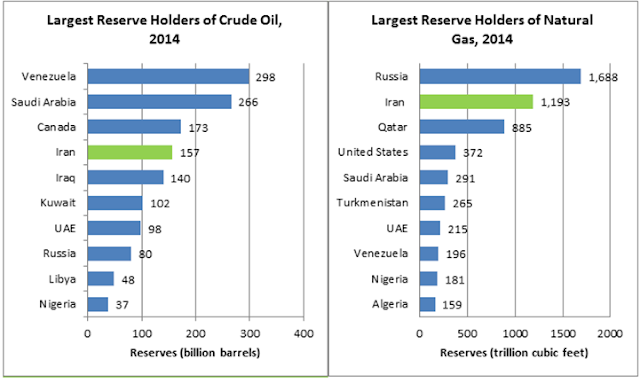A Global Modeling Exercise of Removing Iran’s Sanctions
The proposed lifting of sanctions on Iran, following its July 14, 2015 nuclear agreement with the permanent members of the UN Security Council and Germany (“P5+1”), will have consequences for the global, regional and Iranian economies.
The resumption of Iranian oil exports to pre-2012 levels could eventually add one million barrels per day on the world oil market, bidding down world prices. Iran’s major trading partners, including the United Arab Emirates and other countries in the Middle East and Central Asia, will see an expansion of oil and non-oil trade, as sanctions-induced trading costs come down. Most importantly, as barriers to trade are relaxed, the Iranian economy will shift its production mix in favor of goods that fetch high prices abroad and its consumption towards cheaper imports, with attendant effects on growth, distribution and household welfare.Ianchovichina et al. (2015) quantify the economic effects of the lifting of sanctions on Iran using a modified version of the GTAP 9 database and the global, computable general-equilibrium (CGE) model, as documented in Hertel (1997). CGE models capture the interaction between producers and consumers in the economy, mediated through the price mechanism. The global CGE model used here also captures the trade flows between countries and solves for a set of world prices that equilibrate global supply and demand. The model simulates the effect of a “shock”, such as the removal of a trade sanctions, on the market-clearing prices at the global and national levels. We are therefore able to isolate the consequences of the lifting of sanctions from other ongoing developments in the economy. Since the model captures the new equilibrium of an economy that has been perturbed, the time horizon of a simulation is best thought of as one to two years.In the simulation, the lifting of sanctions on Iran has three components:(i) a lifting of the EU oil sanction;(ii) a reduction in transport costs on trade with Iran; and(iii) improvements in the productivity of cross-border trade in services.The 2012 restrictions on imports of Iranian oil by the EU was the most far-reaching of the sanctions (see below). Its removal is expected to have the largest macroeconomic impact on Iran and the rest of the world: oil accounts for 65 percent of Iranian export revenue and Iran has a relatively large share (8 percent) of total world exports. As cargo inspections on Iranian exports and imports, imposed as part of the sanctions regime, are removed or reduced significantly, transport costs on trade with Iran will decline. This will have an effect on merchandise trade and boost in particular exports of agricultural, machinery, and other goods with large transport margins. And as the US and other partners lift restrictions on finance, tourism and transport trade with Iran, the productivity of cross-border trade in these services will improve. The removal of these restrictions will boost exports of finance, insurance, and tourism exports from Iran.The paper finds that Iran’s gains from the sanctions removal are sizable, resulting in a welfare gain of $13 billion to the economy, or an increase in per capita welfare of 2.8 percent. Most of these gains (2 percent or approximately $10 billion) stem from the lifting of the EU oil sanctions while the reduction in trade costs and improvements in conditions for cross-border trade result in an additional gain of close to one percent. In the global economy, net oil importers gain and net oil exporters lose as the world price of oil declines by about 14 percent in real terms due to the additional amount of oil sold on the global market. That additional one million barrels could cause such a sizeable decline in oil prices is due to the low demand and supply elasticities of oil (Figure 1).
Figure 1. Iran’s
sanctions removal effects on oil prices
The gains to the EU and the US, both net oil importers, are sizable in absolute terms US$74 billion and US$37 billion but small in relative terms as per capita welfare increases by a half of a percent in the EU and a third of a percentage point in the US. The losses are steepest for OPEC members, especially the GCC, which is expected to lose 4.4 percent in per capita welfare (equivalent to US$62 billion in 2011 prices). Per capita welfare for other OPEC members and Russia declines by 3 percent ($22 billion) and 1.8 percent ($34 billion), respectively. The rest of the world is not affected by the reduction in Iran’s trade costs because Iran is responsible for a negligible share of the world’s non-oil exports.
Chart Attribute: Iran's Crude Oil and Natural Gas Reserves, EIA.gov
The removal of the EU oil sanctions will foster an expansion of Iran’s oil sector raising the real price of capital by 8 percent (the oil sector is intensive in capital use) and to a lesser extent the wages of skilled and unskilled Iranian workers (1.1 and 0.4 percent, respectively). The wage increase comes from the spending of oil revenues and not from the direct effect of oil sector expansion as the oil sector employs a negligible share of the Iranian workforce. The boost in overall trade on account of lower trade costs translates into additional increases in wages,especially for skilled labor. Overall, wages of skilled and unskilled labor are expected to go up by 2 and 0.5 percent, respectively, as sanctions on Iran are removed. The supply response to lower trade costs will be negligible but the increases in volumes of exports, albeit from a small base, will be significant: 19 percent for agricultural and food products, 33 percent for metals and mineral products, 13 percent for machinery, 18 percent for textiles, 24 percent for light manufactures, 10 percent for finance and insurance, 7 percent for transport services, and 18 percent for tourism and recreation.

